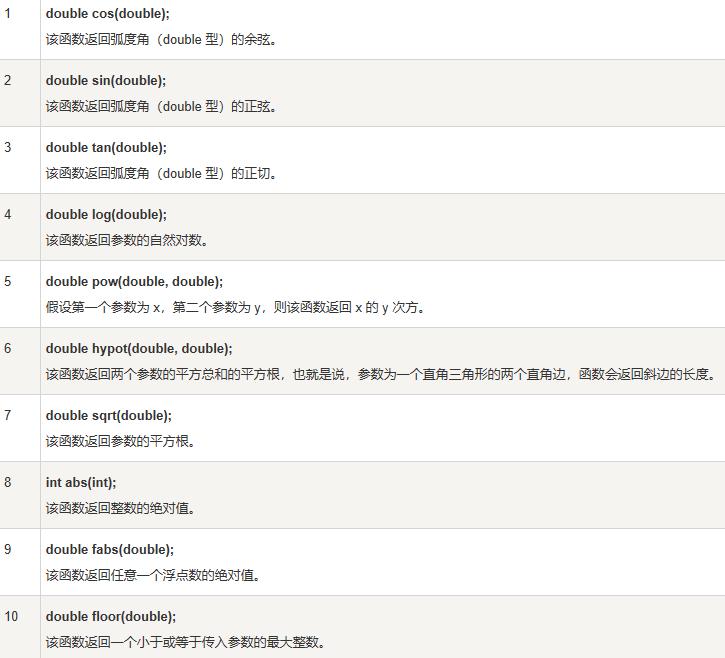c++ 数字
数字
一、定义数字
#include <iostream> using namespace std; int main () { // 数字定义 short s; int i; long l; float f; double d; // 数字赋值 s = 10; i = 1000; l = 1000000; f = 230.47; d = 30949.374; // 数字输出 cout << "short s :" << s << endl; cout << "int i :" << i << endl; cout << "long l :" << l << endl; cout << "float f :" << f << endl; cout << "double d :" << d << endl; return 0; }
结果:
short s :10
int i :1000
long l :1000000
float f :230.47
double d :30949.4
二、数学运算 —— c/c++库 内置数学函数
需要引用数学头文件 <cmath>

三、随机数
关于随机数生成器,有两个相关的函数。一个是 rand(),该函数只返回一个伪随机数。生成随机数之前必须先调用 srand() 函数
#include <iostream> #include <ctime> #include <cstdlib> using namespace std; int main () { int i,j; // 设置种子 srand( (unsigned)time( NULL ) ); //使用 time() 函数 获取 系统时间的秒数 ,作为随机数种子 再调用 rand() 生成 随机数 /* 生成 10 个随机数 */ for( i = 0; i < 10; i++ ) { // 生成实际的随机数 j= rand(); cout <<"随机数: " << j << endl; } return 0; }
结果:
随机数: 1748144778
随机数: 630873888
。。。
补充:
1.

2.取一定范围的随机数
#include <iostream> #include<stdio.h> #include<time.h> #define random(x) (rand()%x) using namespace std; int main() { srand((int)time(0));//部署随机种子 for (int i = 0; i < 10; i++){ cout << random(100) << endl; //输出0-100的随机数 }; return 0; }
3.
(1)rand 随机数产生的范围:在标准的 C 库中函数 rand() 可以生成 0~RAND_MAX 之间的一个随机数,其中 RAND_MAX 是 stdlib.h 中定义的一个整数,它与系统有关,至少为 32767。
(2)使用 rand() 和 srand() 产生指定范围内的随机整数的方法:“模除+加法”的方法。如要产生 [m,n] 范围内的随机数 num,可用: int num=rand()%(n-m+1)+m;(即 rand()%[区间内数的个数]+[区间起点值])



